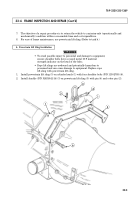TB-9-2320-335-13-P - Page 432 of 680
TB 9-2320-335-13&P
32-2
32-4. FRAME INSPECTION AND REPAIR
This task covers:
a. General Information
d. Preparation and Materials
b. Powertrain Lift Sling Installation
e. Repair Procedures
c. Inspection
f. Powertrain Lift Sling Removal
c.1. Steering Gear Mounting Area Inspection
INITIAL SETUP:
Tools
General mechanic’s tool kit:
automotive (Appendix B, Item 1)
Materials/Parts
Cotter pin (Appendix A, Item 16)
Powertrain lift sling
(TM 9-2320-387-24-2, Appendix D, Figs. 72, 73)
Manual References
TB 750-98-23
TM 9-2320-387-10
TM 9-2320-387-24-1
TM 9-2320-387-24-2
TM 9-2320-387-24P
TC 9-237
TM 43-0139
Equipment Condition
• Vehicle mission equipment removed and
stowed (TM 9-2320-387-10).
• Vehicle undercarriage clean and free of mud
and debris (TM 9-2320-387-10).
• Battery ground cables disconnected
(TM 9-2320-387-24-1).
• Transmission control module removed
(TM 9-2320-387-24-1).
Equipment Condition (Cont’d)
• Engine left splash shield removed (para. 10-23.1).
• Stabilizer bar removed (para. 6-20.1).
• Pitman arm disconnected from center link
(TM 9-2320-387-24-1).
• Steering shaft disconnected from steering gear
(TM 9-2320-387-24-1).
• Oil cooler/brake line bracket removed
(para. 3-7.1).
• Steering gear removed (para. 8-20.1).
General Safety Instructions
• When using power-driven equipment to
straighten frames, all personnel must stand clear.
• Shim material must be under jackstands.
• Ensure shoulder bolts have a raised metal 10.9
material strength indicator on the head of the
bolts.
• Do not bulk heat frame rails to remove bends
and/or buckles.
Maintenance Level
General support
1.
Frame rails are constructed by arc-welding two C-channels of preformed steel together to form a
box-cross section.
2.
Frame rails are internally reinforced at bolt hole locations by bushings or full cross-section spacers
to prevent channels from collapsing from attaching load.
NOTE
Crossmembers and crossmember brackets must be replaced if
damaged.
3.
The frame is made by bolting two non-identical frame rails to crossmembers. Crossmembers are
held to more stringent dimensional tolerances and must be replaced if damaged.
4.
The type of repairs attempted will vary considerably depending on equipment, type of facilities, and
skill of available personnel. Also the choice of procedures will be influenced by parts supply status
and the operational situation.
5.
Mechanical forces involved in frame straightening can lead to safety problems, which all personnel
must constantly consider.
6.
The removal of frame constraints (loosening of crossmember and bracket fastenings) is critical to
allow enough freedom of movement when straightening frame.
a. General Information
Back to Top




















